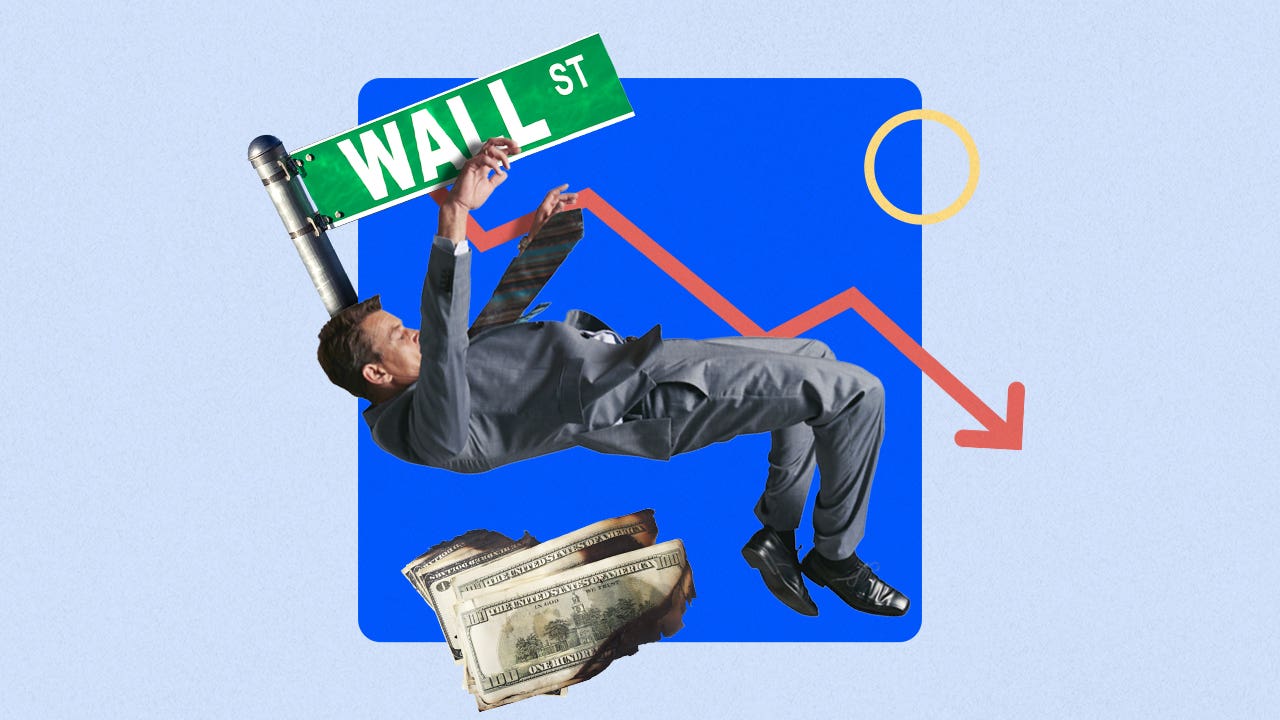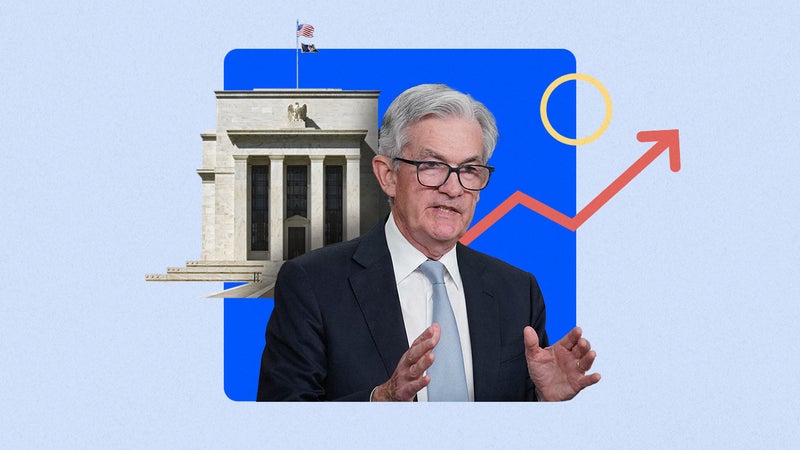Survey: Economists see 59% chance of a recession by July 2024

The Bankrate promise
At Bankrate we strive to help you make smarter financial decisions. While we adhere to strict , this post may contain references to products from our partners. Here's an explanation for .
The U.S. economy has so far avoided what most experts at this time last year assumed to be inevitable for 2023: a recession. Economists, however, still think a downturn is most likely on the horizon.
Experts put the odds of a recession between now and July 2024 at 59 percent, according to the average forecast in Bankrate’s latest quarterly survey of the nation’s top economists. That suggests a roughly 3-in-5 chance, showing probable odds that an economic environment featuring job loss, slower business growth and a tougher stock market is on the horizon.
Illustrating those odds even more, most respondents (78 percent) indicated that the percentage chance of a recession was greater than 1-in-2, while 28 percent said the odds were 70 percent or higher. Just 22 percent said the odds were at 50 percent or lower.
Yet, economists were broadly aligned that the projected recession is unlikely to be as severe as the coronavirus pandemic and the Great Recession — downturns that both pushed unemployment up to double-digit levels.
It’s been a key question for more than a year now: When will the next recession emerge? The odds of one happening in the next year are still seen quite elevated, but the consensus remains that it could be short and shallow.— Mark Hamrick, Bankrate senior economic analyst
Key recession forecasts from Bankrate’s Economic Indicator survey
- Experts put the odds of a recession by July 2024 at 59 percent, suggesting the U.S. economy has a near 3-in-5 chance of contracting.
- Those odds have fallen slightly from the prior survey period in March 2023, with economists penciling in an almost 2-in-3 chance (or 64 percent) of a downturn by the end of 2023.
- Economists’ recession odds suggest a downturn is more probable than not, but those recession odds have also fallen, with the most recent odds hitting the lowest since the second quarter of 2022 survey.
Recession odds for the U.S. economy remain elevated, even if the timing keeps getting pushed back
Recessions are an aspect of the business cycle that’s as inevitable as rain is to weather: It doesn’t take a meteorologist to know that, at some point, it’s going to storm. Yet, few downturns seemed as easy to predict as the one in the aftermath of the post-pandemic inflation burst.
The Federal Reserve has raised interest rates to a level not seen since 2007 — and at a pace not matched since the 1980s. Typically, the Fed has never been able to raise interest rates this far and fast without prompting a downdraft in the business cycle. Historically, the Fed has also never been able to defeat inflation without a recession.
“It has taken a 3 percent or higher real fed funds rate to ’cause a recession,’” says Robert Brusca, chief economist at Fact and Opinion Economics. “The Fed does not act like it wants a recession. But historically, we have never controlled excess inflation without a recession.”
But to the surprise of most economists, that downturn hasn’t yet shown up to crash the economy’s party. To be sure, the economy has slowed from the economy’s grand reopening after pandemic-induced lockdowns, and banks have also tightened lending standards in the wake of three major failures earlier this year. Yet, consumers have continued spending, and the labor market is still chugging along.
Economists’ forecasted recession odds hit the lowest level in a year, when experts penciled in a 52 percent chance that a downturn could begin at some point between June 2022 and December 2023 in a poll for the second quarter of 2022. Recession risks had been steadily rising since the first quarter of 2022, when economists first penciled in a 31 percent chance that a downturn could occur between March 2022 and October 2023.
At the time of the Q1 2022 poll, however, officials at the U.S. central bank were only expecting to raise rates to a peak target range of 2.75-3 percent. The Fed ended up raising interest rates to a target range of 5-5.25 percent, and two more rate hikes are also expected to be on the way, officials said in updated rate projections released with their June decision.
It all means the U.S. economy isn’t out of the recessionary woods. Rather, it just likely hasn’t fully caught up with the tightening in the pipeline so far.
“The effects of higher interest rates are still working their way through the economy,” says Bernard Markstein, president and chief economist of Markstein Advisors. “This makes a mild recession extremely likely, starting in the fourth quarter of this year or the first quarter of next year. The problems in the financial sector are the result of higher interest rates and support my ongoing belief that the U.S. economy is headed to a recession fairly soon.”
Hear from the experts
Given the aggressive tightening by the Fed, the most likely outcome is a recession. The current labor market situation is unsustainable and economic activity will start to cool in late 2023 or early 2024.
— Abbey Omodunbi, senior economistPNC Financial Services
Recent data certainly has pushed the timing of the next recession further down the line around the back-to-school and early holiday shopping season.
— Tuan Nguyen, economistRSM
Most of the indicators used by the NBER to decide whether we are in a recession still point to a very strong economy even with the recent financial volatility. The FOMC has indicated that it wants to tighten monetary policy further this year. Right now, I suspect that could lead to the economy weakening moderately by either late this year or early next year.
— Patrick Horan, research fellowMercatus Center at George Mason University
A number of factors delayed the onset of a recession this year, including the Social Security cost-of-living adjustment in January, the reopening of China’s economy, the loosening of financial conditions in stocks and bank liquidity following the March banking crisis, and residual resilience of the labor market. All those tailwinds are fading now and restrictive monetary policy is expected to dominate. We are still on the path toward at least a mild downturn in the U.S. economy around the end of the year.
— Scott Anderson, chief economist and executive vice presidentBank of the West
-
The Second-Quarter 2023 Bankrate Economic Indicator Survey of economists was conducted June 26-July 5. Survey requests were emailed to economists nationwide, and responses were submitted voluntarily online. Responding were: Odeta Kushi, deputy chief economist, First American Financial Corporation; Tuan Nguyen, economist, RSM US; Yelena Maleyev, economist, KPMG; Scott Anderson, chief economist, Bank of the West; Nayantara Hensel, Ph.D., chief economist, Seaborne Defense; Joel L. Naroff, Naroff Economics; Mike Fratantoni, chief economist, Mortgage Bankers Association; Robert Frick, corporate economist, Navy Federal Credit Union; John E. Silvia, CEO and founder, Dynamic Economic Strategy; Dante DeAntonio, director of economic research, Moody’s Analytics; Bernard Markstein, president and chief economist, Markstein Advisors; Bernard Baumohl, chief global economist, the Economic Outlook Group; Lawrence Yun, chief economist, National Association of Realtors; Robert Brusca, chief economist, Fact and Opinion Economics; Bill Dunkelberg, chief economist, NFIB; Gregory Daco, chief economist, EY; Lindsey Piegza, Ph.D., chief economist, Stifel; Eugenio J. Alemán, Ph.D., chief economist, Raymond James Financial; Patrick Horan, research fellow, Mercatus Center at George Mason University; Abbey Omodunbi senior economist, PNC Financial Services; Ryan Sweet, chief U.S. economist, Oxford Economics; and Mike Englund, chief economist, Action Economics.


